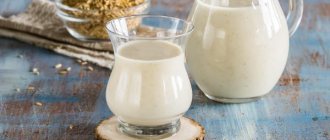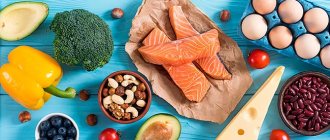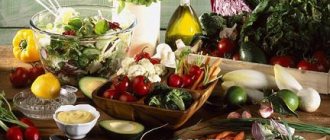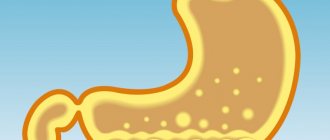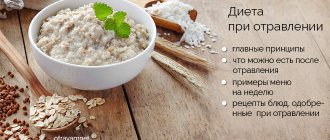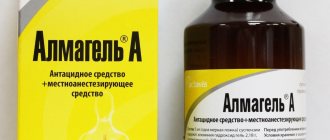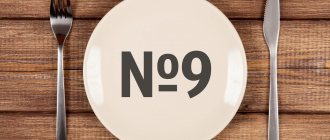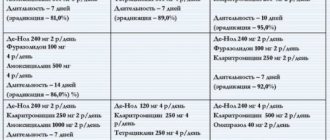11/25/2019 Article
- general characteristics
- Table "Do's and Don'ts"
- Menu for the week
- Diet modifications Diet “Table 1A”
- Diet "Table 1B"
The “1 table” diet , developed by the Soviet nutritionist M.I. Pevzner, is prescribed for the following diseases:
- peptic ulcer of the stomach and duodenum during the recovery period after a sharp exacerbation and with a mild exacerbation;
- mild exacerbation of chronic gastritis with preserved or increased secretion;
- acute gastritis during the recovery period.
The “1 table” diet is considered tough, but it is designed to support the digestive tract and help it recover.
General rules
First of all, let's find out what a therapeutic diet is.
Therapeutic nutrition, in medical terminology “medicinal table”, is prescribed for diseases and is an integral, and in some cases the main, component of treatment. Table No. 1, the Pevzner diet is prescribed for stomach diseases: acute and chronic gastritis , peptic ulcer . Table 1 is also prescribed for gastroduodenitis . Since this is a moderately gentle diet, it is indicated in the stage of recovery or mild exacerbation of the above diseases. It provides chemical, mechanical, as well as thermal sparing of the gastrointestinal tract with physiologically complete nutrition, since the daily diet contains 90-100 g of proteins, 100 g of fats and 420 g of carbohydrates. Calorie content - 2900-3000 kcal per day.
The main points of this diet are:
- Limiting secretion pathogens (broths) and irritants of the mucous membrane, which are spicy dishes and seasonings, raw vegetables.
- Elimination of difficult-to-digest foods and foods that linger in the stomach for a long time.
- The food is cooked and pureed. Baking without a pronounced crust is allowed. When the patient's condition improves, they switch to food without pureeing. In this regard, there are options - a wiped table and not a wiped one. If we are talking about fish and rough meats, then they can be served in pieces.
- Excessively cold and hot dishes are excluded. Cold food suppresses acid-forming functions, but slows down regenerative processes. Too hot also has an adverse effect on the mucous membrane.
- Salt is moderately limited.
- Meals are provided 5-6 times a day, including drinking milk or cream before bed.
Diet No. 1 for gastritis
In acute and exacerbation of chronic gastritis, it helps reduce inflammation and this is achieved by taking pureed and easily digestible food at the same time. After all, a violation of the diet and consumption of food that irritates the gastric mucosa is the cause of the disease, along with alcohol consumption, smoking and nervous tension. It follows that proper nutrition is important in the treatment of chronic gastritis and sequential administration of Diet 1A (up to 7 days), then 1B (up to two weeks) and No. 1 will achieve long-term remission. You can wipe dishes only for the first few days, and then it is enough to choose not rough varieties of meat (chicken, veal) and chew the food thoroughly.
Diet No. 1 (Table No. 1) for gastritis is followed for up to 2-3 months, and then it is recommended to switch to a common table, but with limitation, and sometimes with the exception of overly spicy dishes, seasonings and sauces. For gastritis with high acidity, it is recommended to limit easily digestible carbohydrates (jam, honey, sweets, sugar and other sweets), which reduces the excitability of the stomach and its secretory activity.
Diet number 1 for stomach ulcers
Creates all the conditions for the healing of ulcers, since it does not contain rough food and products that irritate the mucous membrane and stimulate gastric secretion. A sufficient amount of protein has a beneficial effect on reparative processes. Reducing the volume of food taken and split meals leads to mechanical sparing.
Peptic ulcer (stomach ulcer) and duodenal ulcer is a more severe disease and requires long-term drug treatment and dietary nutrition. In case of exacerbation, treatment begins with treatment Table 1A (more gentle, for two weeks). Then for two weeks the patient is recommended Table 1B (mushy and pureed food), and after that - minimally gentle No. 1 (all pureed), which is prescribed for up to six months.
The absence in food during this period of strong irritants that stimulate not only secretory activity, but also the nervous system (ear, meat, mushroom broth, strong tea, coffee, hot, spicy, fried foods, smoked foods, carbonated drinks, horseradish, marinades, mustard, alcohol) creates favorable conditions for successful treatment. Limiting table salt is also necessary, since salt stimulates acid formation in the stomach. Weak juice dishes include: milk, soft-boiled eggs, white crackers, cereals, sweet fruit juices, which must be present in the patient’s diet.
At the same time, the diet should have a high nutritional value (not to be confused with high calorie content), which is determined by the balance of the main food components, vitamins ( A , C , group B ) and mineral salts. Proteins stimulate the healing of ulcerative defects and bind hydrochloric acid in the stomach, which protects the mucous membrane. Fats suppress gastric secretion. In this case, preference is given to vegetable oils. They normalize impaired metabolic processes and promote ulcer repair. Milk is a valuable food product in this regard.
Usually, if patients feel well, their time on this diet is reduced and after 2-3 months. Allow the consumption of unprocessed food with the addition of raw vegetables and fruits. These include sweet plums, peaches, nectarines, apples, and vegetables - tomatoes. Switching to a common table involves regular meals and careful consumption of hot, spicy, too hot foods and alcohol. When carrying out anti-relapse treatment prescribed by a doctor, you should adhere to a gentle diet for 2-4 weeks (first Table No. 1B, and then No. 1).
What is
Patients with ulcers and gastritis with high acidity, both during the period of exacerbation and subsidence of symptoms of the disease, are prescribed diet No. 1. No amateur performances! Only a gastroenterologist should prescribe a diet. This therapeutic gastronomic program is divided into several options: 1, 1a, 1b. Each of them is prescribed depending on the state of the disease and is called a “table”.
As a rule, one treatment program smoothly transitions into another. If the patient has undergone surgery, diet number one is preceded by a surgical zero nutrition system. Table No. 1 is prescribed for inflammatory processes of the stomach and duodenum.
The first diet lasts from 6 months to a year after an exacerbation of the disease. The purpose of the diet is to normalize acidity, eliminate and reduce inflammation, heal ulcers, erosions, and stabilize the secretory function of the stomach. Recovery occurs through diet therapy aimed at maximally sparing the activity of the gastrointestinal tract.
Types of sparing
Chemical - excludes dishes and products that increase secretion, are difficult and take a long time to digest, and require large expenses from the internal organs. The following are prohibited: spicy, highly salted and sour, canned, fatty, smoked, fried, spicy. That is, anything that tastes too bright. This does not mean that for the next six months you will have to eat bland and tasteless food. The diet is balanced, except for exceptions, it contains a lot of permitted foods.
The daily caloric intake should be at least 2800 kcal, but gaining more than 3000 kcal is not recommended. No fasting is envisaged; there should be enough food. Healing meals will be boiled, steamed, baked. You also need to follow a drinking regime; it is recommended to drink a glass of milk at night.
Table No. 1 is a nutrition program balanced in chemical composition. The daily diet will include:
- proteins – up to 100 g, including animals;
- carbohydrates – 400-420 g;
- fats – 100 g, including animal and vegetable.
Mechanical sparing excludes large pieces of food. In a patient, such food increases the motility of the digestive tract, which provokes nausea, vomiting, heartburn and similar unpleasant symptoms. Diet number one includes soft foods: pureed, pureed, finely chopped. If the dish is baked, it should be without a crust. Boiled lean meat and fish can be eaten unchopped, served in a whole piece. Food should be taken frequently and in moderation. In addition, foods high in fiber are limited: radishes, turnips, mushrooms, cabbage (except cauliflower), legumes, etc. We will consider the full list of prohibited and permitted foods for table No. 1 below.
Thermal – involves eating food at the optimal temperature. The optimal food temperature when prescribing diet No. 1 should be no lower than 15 degrees and no higher than 60 degrees. If food irritates the mucous membrane of the mouth, it is not suitable: it needs to be heated or cooled. Everything should be warm: appetizers and salads, soups and mains. Such a treatment program, with some correction, is sometimes prescribed to patients with pancreatitis, diabetes mellitus with accompanying problems of the gastrointestinal tract.
So, on diet No. 1 according to Pevzner, you need to eat your fill, measuredly, and use only prescribed foods for dietary meals. For clarity, let’s look at the products for table No. 1 and a sample menu for the week.
Varieties
The varieties are Diet 1A and 1B , which differ from the main one in indications and method of processing food. Table 1A is indicated for severe exacerbation of peptic ulcer (for the first 6-8 days), exacerbation of chronic gastritis (for 4-5 days), for acute gastritis (for 2-3 days) and burn of the esophagus. Therapeutic nutrition provides maximum sparing, food is only pureed and in liquid form, given that patients are on bed rest.
Table 1B is prescribed after the previous one for the same diseases, but when the process subsides. Nutrition provides for significant sparing of the gastrointestinal tract, but since the patient’s condition is improving and he is on semi-bed rest, food is served in puree form. The varieties also include Table 1A surgical and 1B surgical, since they are prescribed after surgery on the gastrointestinal tract on the 3-4th day after the zero diet 0A, which is on the first two days. Surgical diets necessarily contain weak broths, as well as pureed cereal soups and steamed meat or fish souffle.
Description of the diet, to whom it is indicated
Table 1 - diet (the menu for the week will be given below), which was introduced for therapeutic nutrition by physician M.I. Pevzner. It was invented specifically to normalize the digestive process for patients suffering from diseases of the gastrointestinal tract.
Everyone knows that with such diseases it is difficult for the body to digest regular food, and problems such as nausea, heartburn, diarrhea, abdominal pain, etc. begin. Therefore, the patient will have to give up some foods.
This diet is an integral (and sometimes the main) part of the treatment of diseases of the gastrointestinal tract. If it is carefully observed, the patient’s well-being quickly improves, and if it is violated (intentionally or accidentally), a sharp deterioration in the condition occurs. Therefore, it is recommended to strictly follow the diet, avoiding the consumption of prohibited foods.
For what diseases is this diet recommended?
- Gastritis in acute and chronic form;
- Peptic ulcer of the stomach and duodenum;
- Burn of the esophagus;
- Condition after surgery on the stomach;
- Gastroduodenitis.
This diet has a gentle effect on the digestive organs, accelerating the healing process of the mucous membrane.
Authorized Products
The first table diet according to Pevzner involves preparing first courses in potato broth or vegetable broth with pureed vegetables, pureed or boiled cereals (semolina, buckwheat, rolled oats, rice). You can eat milk noodle soups, as well as puree soups with the addition of pureed chicken or meat. Flour for seasoning soups is not fried, but only dried, an egg-milk mixture is added to them, and the finished ones are seasoned with butter or cream.
Steamed meat cutlets
Steamed and boiled dishes are prepared from lean meat without tendons, fascia and skin. For this purpose, beef, young lamb and lean pork, chicken and turkey, tongue, and liver are used. You can use them to prepare steamed cutlets, dumplings, aspic, soufflé, meatballs, mashed potatoes, zrazy, beef stroganoff (only from pre-boiled meat). Boiled meat is allowed - veal, chicken, rabbit and meat baked in the oven. Low-fat types of fish are steamed and served in pieces (the skin is first removed) or in the form of meatballs, cutlets, meatballs, etc.
Wheat bread is allowed stale (yesterday's) or dried. You can use dry biscuit or biscuits. Once a week you can allow baked savory pies with apples, jam or cottage cheese, meat or fish. Semolina, rice, buckwheat or oatmeal, noodles or pasta are added to garnishes and soups. Porridge can be boiled in milk or water, boiled well until semi-viscous, or pureed (buckwheat). It is allowed to make steam soufflés and puddings with the addition of cottage cheese from cereals.
Vegetables (potatoes, beets, young peas, carrots, cauliflower) are steamed, pureed and served as a side dish in the form of puree and soufflé. Only pumpkin and zucchini, as well as ripe, non-acidic tomatoes, can be ungrated. Dill is added in small quantities to soups. Butter and vegetable oil are added to prepared dishes.
Among dairy products, milk and cream, yogurt and kefir (non-acidic), fresh non-acidic cottage cheese, curd cheese and sour cream are allowed. You can use cottage cheese to make lazy dumplings, baked cheesecakes, and puddings. Allowed infrequently are mild cheese in grated form, 2 eggs twice a week, which are cooked soft-boiled or in the form of an omelet and egg porridge. Among the appetizers on a fresh table, you can allow a salad of boiled vegetables, boiled meat and fish, liver pate, doctor's or milk sausage, jellied fish in a vegetable broth, lean herring, sturgeon caviar and lean ham.
Sweet desserts are prepared by steaming pureed berries with the addition of semolina. Sweet berries and fruits are allowed when baked or boiled. You can use them to make purees, jelly, jelly, sambuca, and compotes. Meringues, milk jelly, marshmallows, marshmallows, non-sour jam, and honey are allowed as desserts. Drinks include fruit juices, rosehip infusion, tea with milk or cream, and weak coffee with milk.
Table of permitted products
| Proteins, g | Fats, g | Carbohydrates, g | Calories, kcal | |
Vegetables and greens | ||||
| zucchini | 0,6 | 0,3 | 4,6 | 24 |
| cauliflower | 2,5 | 0,3 | 5,4 | 30 |
| potato | 2,0 | 0,4 | 18,1 | 80 |
| carrot | 1,3 | 0,1 | 6,9 | 32 |
| beet | 1,5 | 0,1 | 8,8 | 40 |
| pumpkin | 1,3 | 0,3 | 7,7 | 28 |
Fruits | ||||
| apricots | 0,9 | 0,1 | 10,8 | 41 |
| watermelon | 0,6 | 0,1 | 5,8 | 25 |
| bananas | 1,5 | 0,2 | 21,8 | 95 |
| melon | 0,6 | 0,3 | 7,4 | 33 |
| nectarine | 0,9 | 0,2 | 11,8 | 48 |
| peaches | 0,9 | 0,1 | 11,3 | 46 |
| apples | 0,4 | 0,4 | 9,8 | 47 |
Berries | ||||
| strawberry | 0,8 | 0,4 | 7,5 | 41 |
| raspberries | 0,8 | 0,5 | 8,3 | 46 |
Cereals and porridges | ||||
| buckwheat (kernel) | 12,6 | 3,3 | 62,1 | 313 |
| semolina | 10,3 | 1,0 | 73,3 | 328 |
| cereals | 11,9 | 7,2 | 69,3 | 366 |
| white rice | 6,7 | 0,7 | 78,9 | 344 |
Bakery products | ||||
| white bread crackers | 11,2 | 1,4 | 72,2 | 331 |
Confectionery | ||||
| jam | 0,3 | 0,2 | 63,0 | 263 |
| jelly | 2,7 | 0,0 | 17,9 | 79 |
| marshmallows | 0,8 | 0,0 | 78,5 | 304 |
| meringues | 2,6 | 20,8 | 60,5 | 440 |
| paste | 0,5 | 0,0 | 80,8 | 310 |
| Maria cookies | 8,7 | 8,8 | 70,9 | 400 |
Raw materials and seasonings | ||||
| honey | 0,8 | 0,0 | 81,5 | 329 |
| sugar | 0,0 | 0,0 | 99,7 | 398 |
| milk sauce | 2,0 | 7,1 | 5,2 | 84 |
Dairy | ||||
| milk | 3,2 | 3,6 | 4,8 | 64 |
| kefir | 3,4 | 2,0 | 4,7 | 51 |
| cream | 2,8 | 20,0 | 3,7 | 205 |
| sour cream | 2,8 | 20,0 | 3,2 | 206 |
| curdled milk | 2,9 | 2,5 | 4,1 | 53 |
Cheeses and cottage cheese | ||||
| cottage cheese | 17,2 | 5,0 | 1,8 | 121 |
Meat products | ||||
| boiled beef | 25,8 | 16,8 | 0,0 | 254 |
| beef liver | 17,4 | 3,1 | 0,0 | 98 |
| boiled beef tongue | 23,9 | 15,0 | 0,0 | 231 |
| boiled veal | 30,7 | 0,9 | 0,0 | 131 |
| rabbit | 21,0 | 8,0 | 0,0 | 156 |
Bird | ||||
| boiled chicken | 25,2 | 7,4 | 0,0 | 170 |
| turkey | 19,2 | 0,7 | 0,0 | 84 |
Eggs | ||||
| chicken eggs | 12,7 | 10,9 | 0,7 | 157 |
Fish and seafood | ||||
| black caviar | 28,0 | 9,7 | 0,0 | 203 |
| salmon caviar granular | 32,0 | 15,0 | 0,0 | 263 |
Oils and fats | ||||
| butter | 0,5 | 82,5 | 0,8 | 748 |
| ghee | 0,2 | 99,0 | 0,0 | 892 |
Non-alcoholic drinks | ||||
| mineral water | 0,0 | 0,0 | 0,0 | — |
| coffee with milk and sugar | 0,7 | 1,0 | 11,2 | 58 |
| black tea with milk and sugar | 0,7 | 0,8 | 8,2 | 43 |
Juices and compotes | ||||
| apricot juice | 0,9 | 0,1 | 9,0 | 38 |
| carrot juice | 1,1 | 0,1 | 6,4 | 28 |
| pumpkin juice | 0,0 | 0,0 | 9,0 | 38 |
| * data is per 100 g of product | ||||
Food Frequently Asked Questions
Below we will look at a number of frequently asked questions.
Is it possible to eat fruits and what kind?
You can eat sweet fruits and berries in the form of puree, jelly, baked, drink berry compotes, jelly, diluted juices. Varieties include bananas, apples, peaches, pears, nectarines, apricots, and berries: strawberries, raspberries, cherries.
What types of lean meat and fish are allowed? Chicken, beef, rabbit, turkey, and lean lamb are allowed from animal and poultry meat. Fish allowed are hake, pollock, cod, saury, blue whiting, pike, and perch.
Fully or partially limited products
A complete exclusion of vegetables rich in fiber (radish, turnip, white cabbage, beans, peas, rutabaga, unpeeled fruits) and foods with connective tissue (cartilage, sinew, skin of birds and fish) is provided. The following are excluded from meat products: fatty pork, duck, lamb, goose, canned meat and smoked meats. There is also a ban on highly extractive broths, rich vegetable decoctions and soups cooked with them. It is necessary to exclude cabbage soup, okroshka and borscht from the first courses. The following vegetables and herbs are excluded: sorrel, dill, parsley, spinach, onions, as they contain large amounts of organic acids or irritating essential oils. Mushrooms are a difficult to digest product.
Pickled and pickled vegetables and canned vegetables, which cause increased secretion of gastric juice, are excluded from the diet. Millet, pearl barley, barley and corn, as they are difficult to digest. Fatty fish and canned fish are prohibited. It should be taken into account that hard-boiled and fried eggs are poorly digestible, so they are excluded in this form. Do not consume meat sauces, tomato sauce, horseradish, mustard, pepper that irritate the gastric mucosa; avoid cooking fat and animal fats. Any fresh bread, butter and puff pastry, dried fruit, chocolate and ice cream are prohibited. You should not consume dairy products with high acidity, which stimulate secretion. For the same reason, sour and unripe fruits and berries are excluded. Limit sour cream.
Table of prohibited products
| Proteins, g | Fats, g | Carbohydrates, g | Calories, kcal | |
Vegetables and greens | ||||
| vegetables legumes | 9,1 | 1,6 | 27,0 | 168 |
| swede | 1,2 | 0,1 | 7,7 | 37 |
| cabbage | 1,8 | 0,1 | 4,7 | 27 |
| sauerkraut | 1,8 | 0,1 | 4,4 | 19 |
| green onion | 1,3 | 0,0 | 4,6 | 19 |
| bulb onions | 1,4 | 0,0 | 10,4 | 41 |
| cucumbers | 0,8 | 0,1 | 2,8 | 15 |
| canned cucumbers | 2,8 | 0,0 | 1,3 | 16 |
| white radish | 1,4 | 0,0 | 4,1 | 21 |
| turnip | 1,5 | 0,1 | 6,2 | 30 |
| canned tomatoes | 1,1 | 0,1 | 3,5 | 20 |
| horseradish | 3,2 | 0,4 | 10,5 | 56 |
| spinach | 2,9 | 0,3 | 2,0 | 22 |
| sorrel | 1,5 | 0,3 | 2,9 | 19 |
Mushrooms | ||||
| mushrooms | 3,5 | 2,0 | 2,5 | 30 |
Cereals and porridges | ||||
| corn grits | 8,3 | 1,2 | 75,0 | 337 |
| pearl barley | 9,3 | 1,1 | 73,7 | 320 |
| millet cereal | 11,5 | 3,3 | 69,3 | 348 |
| barley grits | 10,4 | 1,3 | 66,3 | 324 |
Confectionery | ||||
| candies | 4,3 | 19,8 | 67,5 | 453 |
Ice cream | ||||
| ice cream | 3,7 | 6,9 | 22,1 | 189 |
Cakes | ||||
| cake | 4,4 | 23,4 | 45,2 | 407 |
Raw materials and seasonings | ||||
| mustard | 5,7 | 6,4 | 22,0 | 162 |
| ginger | 1,8 | 0,8 | 15,8 | 80 |
| ketchup | 1,8 | 1,0 | 22,2 | 93 |
| mayonnaise | 2,4 | 67,0 | 3,9 | 627 |
| ground black pepper | 10,4 | 3,3 | 38,7 | 251 |
| chilli | 2,0 | 0,2 | 9,5 | 40 |
Meat products | ||||
| pork | 16,0 | 21,6 | 0,0 | 259 |
| ham | 22,6 | 20,9 | 0,0 | 279 |
Sausages | ||||
| dry-cured sausage | 24,1 | 38,3 | 1,0 | 455 |
| sausages | 10,1 | 31,6 | 1,9 | 332 |
| sausages | 12,3 | 25,3 | 0,0 | 277 |
Bird | ||||
| smoked chicken | 27,5 | 8,2 | 0,0 | 184 |
| duck | 16,5 | 61,2 | 0,0 | 346 |
| smoked duck | 19,0 | 28,4 | 0,0 | 337 |
| goose | 16,1 | 33,3 | 0,0 | 364 |
Fish and seafood | ||||
| dried fish | 17,5 | 4,6 | 0,0 | 139 |
| smoked fish | 26,8 | 9,9 | 0,0 | 196 |
| canned fish | 17,5 | 2,0 | 0,0 | 88 |
Oils and fats | ||||
| animal fat | 0,0 | 99,7 | 0,0 | 897 |
| cooking fat | 0,0 | 99,7 | 0,0 | 897 |
Non-alcoholic drinks | ||||
| bread kvass | 0,2 | 0,0 | 5,2 | 27 |
| * data is per 100 g of product | ||||
Reviews from nutritionists
Most nutritionists approve of this diet for diseases of the gastrointestinal tract.
Here are some reviews from doctors:
- Diet No. 1 is effective for gastritis, gastroduodenitis, and stomach ulcers. If followed correctly, the patient’s condition improves noticeably, the mucous membrane heals quickly, and acidity returns to normal. A rapid regression of the inflammatory process is noticeable.
- Some people believe that table number 1 implies a complete abstinence from salt, but this is wrong. It is enough to limit its amount to 5 g per day. But the volume of fluid consumed should be increased; this concept does not include tea, coffee, compotes, etc.
Judging by the reviews of doctors and recovered patients, this diet is very useful. The only thing that makes it difficult to use table number 1 is constantly thinking about how to create a menu for the day, week, etc. But it is economical and helps to get rid of excess weight.
Menu (Power Mode)
As we found out, for gastritis and peptic ulcers, the basis is the therapeutic Diet 1st table. The menu for the week should include alternating a variety of protein (beef, chicken, fish, rabbit, turkey, cottage cheese) and cereal dishes.
Below is a menu for the day and a sample menu for the week; it can be modified without going beyond the permitted products and observing the basic principles of heat treatment. In this case, you need to take into account what diet you are prescribed - with pureed dishes or not pureed. Many people do not tolerate milk well, so you can drink it in small quantities and warm, add it to tea and weak coffee. It is also permissible to use non-acidic kefir or yogurt.
Monday
| Breakfast |
|
| Lunch |
|
| Dinner |
|
| Afternoon snack |
|
| Dinner |
|
| For the night |
|
Tuesday
| Breakfast |
|
| Lunch |
|
| Dinner |
|
| Afternoon snack |
|
| Dinner |
|
| For the night |
|
Wednesday
| Breakfast |
|
| Lunch |
|
| Dinner |
|
| Afternoon snack |
|
| Dinner |
|
| For the night |
|
Thursday
| Breakfast |
|
| Lunch |
|
| Dinner |
|
| Afternoon snack |
|
| Dinner |
|
| For the night |
|
Friday
| Breakfast |
|
| Lunch |
|
| Dinner |
|
| Afternoon snack |
|
| Dinner |
|
| For the night |
|
Saturday
| Breakfast |
|
| Lunch |
|
| Dinner |
|
| Afternoon snack |
|
| Dinner |
|
| For the night |
|
Sunday
| Breakfast |
|
| Lunch |
|
| Dinner |
|
| Afternoon snack |
|
| Dinner |
|
| For the night |
|
Table 1b
Best materials of the month
- Coronaviruses: SARS-CoV-2 (COVID-19)
- Antibiotics for the prevention and treatment of COVID-19: how effective are they?
- The most common "office" diseases
- Does vodka kill coronavirus?
- How to stay alive on our roads?
The rules of the diet are typical for the previous options: fractional meals, warm food, pureed and soft dishes, a minimum of salt. Diet 1b is prescribed after exacerbations, during the period of attenuation of complications with gastritis and gastric and duodenal ulcers. During the period of adherence to table 1b, the patient is shown semi-bed rest.
The list of foods that should not be consumed is the same as in No. 1 with additional restrictions. Fermented milk drinks are completely excluded. You can eat dry bread, but not much (up to 100 grams). Any boiled meat must be finely chopped or pureed; it is recommended to grind it twice. Fruits and vegetables in their natural form are prohibited. They can be boiled, made into jellies, soufflés, mousses, and compotes. Also exclude coffee, soda and cocoa.
For breakfast, you can prepare porridge from semolina or oatmeal with water, steam omelets, you can add vegetables to them. For afternoon snacks and lunch, baked fruits (allowed), soufflé, warm milk, and tea with milk are suitable. Lunch must include liquid food: pureed rice or pearl barley soups, light vegetable broths. For dinners, pureed cereals, steamed meat and vegetables, and purees are suitable. A few hours before bedtime, you should drink 250-300 ml of warm milk. Thermal sparing (15-65 degrees) and frequency of meals must also be observed. After the patient’s well-being improves, they are transferred to diet No. 1.
Diet No. 1, cooking recipes
Below are recipes for first table dishes that are easy to prepare at home. You need to know that the “poaching” cooking method is used for products with a high water content and having a delicate consistency: fish, many vegetables, products made from quenelle mass. It is carried out in saucepans or pans with a closed lid in water, covering no more than 1/3 of the product.
When steaming, the product should not come into contact with the liquid and is steamed while boiling. Therefore, the loss of nutrients is less than with the previous cooking method. Steam cooking is best done in a double boiler, or, if one is not available, in a regular pan with a mesh liner. Cooking in a water bath is carried out at 40-70°C. Prepare in a container, which is placed in another with hot water poured in. In diets. In this way, omelettes, puddings and egg porridge are prepared.
First meal
Oatmeal soup with pureed vegetables and vegetable oil
Ingredients: ground oatmeal or oatmeal, 50 ml cream, 100 g vegetables, vegetable oil, salt, 2 glasses of water.
Boil potatoes, zucchini and carrots, blend in a blender. Dilute the mixture with the vegetable broth in which the vegetables were cooked, bring to a boil and add ground oatmeal and cook for 2-3 minutes. Pour in vegetable oil and cream, salt.
Cream soup with rice flour, zucchini and carrots
Peel, cut and cook zucchini and carrots, then rub through a metal sieve. Mix rice flour with pureed vegetables, add water, season with beaten egg-milk mixture, add butter, salt and bring to a boil.
Ingredients: 50 g rice flour, 200 g zucchini and 150 g carrots, half an egg, 150 g milk, butter, salt.
Second courses
Fish dumplings
Products: 300 g fish - 50 bread, 50 ml milk, melted butter.
Grind the fish fillet through a meat grinder, add white bread soaked in milk (it can be replaced with semolina). Mix well and add salt. Using two tablespoons, form oblong quenelles and place in a saucepan, fill 1/3 with water, cover with a lid and simmer for 5-7 minutes. Ready to pour oil.
Steamed chicken cutlets with dill
Grind the chicken breast through a meat grinder, add soaked white bread, melted butter, dill and salt to the minced meat. Form cutlets and place in a steamer container. Cook for 10-12 minutes. Ready to drizzle with melted butter.
Ingredients: 500 chicken fillets, 150 g of bread, 100 ml of milk, butter, salt, dill.
Egg porridge
The eggs are diluted with milk and beaten, salt and butter are added, the mixture is poured into a bowl, which is placed in a pan of water. Cook while stirring until the consistency of porridge. It can be prepared in another way: the egg mass is poured into a pan with warm water (in a small amount) and cooked like regular porridge until thickened. The remaining water is filtered off.
Ingredients: 2 eggs, 60 ml milk, salt, 2 tsp. oils
Dessert
Carrot soufflé with cottage cheese and honey
Products: 500 g carrots - 250 g cottage cheese, 150 g milk, 1 des. l. sugar, 1 egg, 50 g semolina, butter.
Cut the carrots into pieces, add milk and boil until tender. Rub or beat in a blender, add pureed cottage cheese, sugar, yolk and semolina. Mix the mixture thoroughly and add the beaten egg whites last. Place in a suitable container, greased with oil, and steam. Serve with honey.
Meringues
Beat the whites until foamy and add half the powder. Add all the powdered sugar while stirring gently with a spatula. Do not add powder at the beginning of beating the egg whites! Spoon the protein-sugar mixture onto a baking sheet lined with parchment paper. Bake at low temperature 80-1000 for 1-1.5 hours (this depends on the size).
Ingredients: 4 egg whites, 1 cup powdered sugar.
Dessert
Desserts can be served for lunch or afternoon tea.
Curd soufflé with honey
- Mix 200 g of low-fat cottage cheese with 100 g of milk.
- Add 1 tsp. sugar, mix thoroughly.
- Add egg yolk and 50 g semolina, mix.
- Add beaten egg white.
- Place in a bowl coated with oil.
- Steam.
Meringues
- Beat 4 egg whites.
- Add powdered sugar carefully.
- Spoon the egg white mixture onto a baking sheet lined with parchment paper.
- Bake in the oven at a very low temperature (about 100 degrees) for an hour.
You can also come up with many other dessert recipes.
For children
Gastritis is often recorded in even young children: problems with appetite and belching appear, the child complains of pain in the stomach. It is very important to properly organize the child’s diet: five times a day at the same time. Children are also prescribed the 1st dietary table and its varieties depending on the stage (exacerbation or recovery period).
The diet and method of processing food does not differ from that of adults. Food should only be freshly prepared, and not “prepared for future use.” Of course, this requires time and care on the part of parents. When cooking, it is not permissible to use any flavoring additives - only natural food.
The therapeutic effect is achieved due to the absence of foods high in coarse fiber in the diet, as well as reducing the volume of food taken. This is especially important for children. The volume of food and overdistension of the stomach affect its secretory and motor function. You also need to consider the length of time the food stays in the stomach. So, if boiled vegetables and boiled meat linger in the stomach for 3-4 hours, then fried meat, lentil puree, herring and peas for up to 4-5 hours. The shortest digestion time is observed when taking broth and soft-boiled eggs - 1-2 hours and 2-3 hours for digestion of milk, jelly, compotes, scrambled eggs, stewed fish, dry liver and white bread.
It is important to take into account the fact that the number of gastric glands depends on the age of the child: in a newborn - 2 million, at 10 years old - 17 million, and at 15 years old - 22 million. In this regard, it is obvious that the diet should be individualized depending on age and degree of gastric secretion and its disorders.
As for the duration of therapeutic nutrition, it depends on the severity of the process. For acute gastritis - a short period of 2-3 weeks, and for chronic lesions - for a longer period (several months). As you recover, you need to use a “zigzag” diet: expanding the diet for a short time and then returning to a gentle diet again. Such nutrition has a training effect and revitalizes regenerative processes. Even with recovery, you should not give your child canned food and limit fried foods and rough foods.
Features of the diet for gastritis
Thanks to the use of diet No. 1, an improvement in the condition of acute and chronic gastritis is achieved quite quickly by reducing inflammation of the gastric mucosa. Puréed food must be consumed for the first 5-7 days, then you can only select soft varieties of meat (chicken, veal) and chew the food well.
Diet 1 for gastritis is recommended to be followed for quite a long time - about six months. In this case, sweets will have to be limited, such as: honey, sweets, jam, because... they cause irritation of the mucous membrane and increased acidity.
Advantages and disadvantages
| pros | Minuses |
|
|
Features of the diet for pancreatitis
If gastritis is accompanied by inflammation of the pancreas, then table No. 1 must be combined with the recommendations of table No. 5. If at table 1 it is recommended to drink milk more often, then with pancreatitis it is forbidden to drink it in its pure form. But you can add it to porridges, soups, and also replace it with kefir.
Also, if you have pancreatitis, it is not recommended to use butter; you will have to cook food without it in the first days.
Reviews and results
Medical nutrition does not mean monotony and tastelessness of dishes. You can diversify it with new dishes - just don’t be lazy and do everything to restore your health. Reviews from patients indicate that this diet has a beneficial effect on the gastrointestinal tract. Already in the first week, pain and discomfort in the stomach decrease, belching and heartburn .
- “... For peptic ulcers, diet table number 1 was prescribed, and I followed it completely for five months! I admit that the first time was painful, and I often “violated” it, but the ulcer immediately began to remind itself. After a month it became much better, and after five months nothing bothered me anymore and I began to eat everything. Nutritional therapy makes sense";
- “... I cooked this way for my child when, at the age of 5, he developed belching, poor appetite, and constipation. After the examination, they diagnosed gastritis and told me to definitely monitor my diet. I don’t even know why this happened - he goes to kindergarten, where he has proper nutrition”;
- “...Table number one is my main diet during an exacerbation of an ulcer. It’s a pity that due to the nature of my work (frequent business trips), I can’t eat for so long and return to it when I’m at home. You immediately feel relief, it doesn’t hurt and doesn’t suck in the pit of your stomach. It’s bad that now you can’t find catering with dietary dishes”;
- “... I really regret that I didn’t stick to the diet at one time, when there were exacerbations of the ulcer up to three times a year. Now after the perforation and surgery I’m simply forced to eat right. Yes, it’s difficult and troublesome, but my wife organized everything for me: I take trays of porridge, stewed vegetables and boiled chicken or diet meatballs to work. Sometimes I make “quick” porridge for a snack.”
Contraindications
Despite the fact that this diet is useful, it still has its contraindications.
Who should not use table No. 1:
- people with milk intolerance;
- those who underwent surgery on the gastrointestinal tract on the first day after surgery (fasting is required);
- patients with acute pancreatitis (fasting is recommended on the first day of the disease).
There are no other contraindications to this diet.
Menu for one day (without chopping food)
- 1st breakfast: egg, crumbly buckwheat, black tea with milk.
- 2nd breakfast: decoction of rose hips, fresh non-acidic cottage cheese.
- Lunch: vegetarian soup with potatoes, boiled or baked meat, boiled carrots. We drink compote made from dried fruits.
- Afternoon snack: wheat bran boiled with sugar and breadcrumbs.
- Dinner: baked or boiled fish with sauce, apple and carrot puree, black tea with milk.
- Before going to bed, drink a glass of milk or cream.
What foods should you not eat?
Heavy food harms the body.
With this type of treatment table, the consumption of difficult-to-digest foods, as well as those that take a long time to digest, is not allowed. Salt in food is limited. There are thermal limitations. You should not eat too cold or too hot food - the first reduces the regenerative process, the second negatively affects the mucous membranes.
To take care of mucous membranes, seasonings, spicy, smoked, and fried foods are excluded. Mushroom dishes take a long time to digest.
Eggs are only allowed boiled, with a semi-liquid yolk or in the form of a steam omelet. Hard-boiled and fried eggs are too difficult to digest.
Raw vegetables high in fiber (radishes, beans, green peas, cabbage inflorescences) are prohibited. Canned, fermented, salted and pickled preparations are not allowed. Herbs include sorrel, dill, parsley, spinach, onion. They contain a lot of organic acids, which additionally irritate the gastrointestinal tract.
Only weak broths are allowed. Among the soups, cabbage soup, borscht, and okroshka are prohibited.
Myths about nutrition for ulcer patients
Finally, let’s dispel a few myths about the nutrition of ulcer patients.
Actually, there is only one myth: You will have to eat tasteless pureed food! Nutritionists have already reconsidered their previous strictness and do not insist that patients bring all their dishes to the state of liquid puree. The main thing is to adhere to general principles and find a positive aspect in such nutrition.
It would seem that a diet with boiled and steamed products is a green melancholy, but if you look at things philosophically, then where else can you find puddings and quenelles, soufflés and pates, mousses, meringues and cream soups. At least you can have a real feast at home. Well, if you take care of yourself more closely, then the time of culinary retreat can be reduced.
Diet table number 1 for children
Diet table number one can be prescribed by specialists as a therapeutic nutrition system for some childhood gastrointestinal diseases. The list of restrictions and recommendations regarding cooking methods are the same as in dietary table No. 1 for adults, but for children the pureed version of the menu is almost always recommended.
Author of the article:
Kuzmina Vera Valerievna |
Endocrinologist, nutritionist Education: Diploma of the Russian State Medical University named after. N.I. Pirogov, specialty “General Medicine” (2004). Residency at the Moscow State Medical and Dental University, diploma in Endocrinology (2006). Our authors
Indications for prescribing treatment table No. 1
Medical diet number 1 is prescribed for:
- peptic ulcer;
- exacerbation of chronic gastritis with normal or high acidity;
- acute gastritis in the recovery stage;
- with gastroduodenitis;
- infectious diseases of the gastrointestinal tract (in the absence of diarrhea);
- diaphragmatic hiatus hernia;
- the indication for the appointment of table No. 1 is gastrointestinal oncology.
The main symptoms of gastrointestinal diseases: pain in the epigastric region, nausea, vomiting, belching, loss of appetite. The appearance of one or more symptoms is a reason to visit a doctor. Diet table 1 is designed to provide peace to the gastric mucosa and the possibility of its speedy recovery.
How and why ulcers occur
The stomach performs an important job every day - digesting food. Its walls are covered with a protective layer of mucus, which prevents hydrochloric acid from destroying mucosal cells. Also protective functions are performed by:
- Bicarbonates. Contains gastric juice. Formed as a result of the activity of mucoid cells.
- Prostaglandins. Refers to lipid substances. Responsible for protecting the walls of the stomach, preventing the occurrence of ulcers.
- Mucosal cells that are continuously regenerated.
- Blood supply system.
The process of developing a peptic ulcer goes through the following stages:
- The occurrence of a mucosal defect caused by an aggressive environment.
- Disruption of cell activity, which leads to a decrease in the level of bicarbonates and prostaglandins. The layer of protective mucus loses its integrity.
- Gastric juice begins to irritate the walls of the stomach. Erosive damage occurs.
- The damage grows deeper. As a result, an ulcer is formed that affects the mucous membrane and deep muscle layers. If left untreated, gastric perforation may occur.
Reasons that can trigger the occurrence of peptic ulcer:
- Uncontrolled use of antipyretic, anti-inflammatory, analgesic drugs.
- Helicobacter pylori infection.
- A stressful condition in which blood supply and the production of protective enzymes are disrupted.
- Increased acidity.
- Smoking.
- Eating spicy, fried, hot foods, fast food.
- Alcohol abuse.
Excluded foods and dishes of the diet table No. 1
Foods that cause pain, stimulate secretion, or irritate the walls of the gastrointestinal tract should be excluded from the diet. Namely: pickles, smoked foods, canned food, marinades, seasonings, sauces, carbonated drinks (including kvass). Also exclude strong tea and coffee, strong meat and fish broths, fried and stewed dishes, mushrooms, fresh bread, rye bread, butter dough, sour dairy products, sharp cheeses, coarse cereals (millet, corn, barley and pearl barley), sorrel , onions, cucumbers, tomatoes, legumes, white cabbage, spinach, turnips, radishes, radishes, sour fruits and berries.
